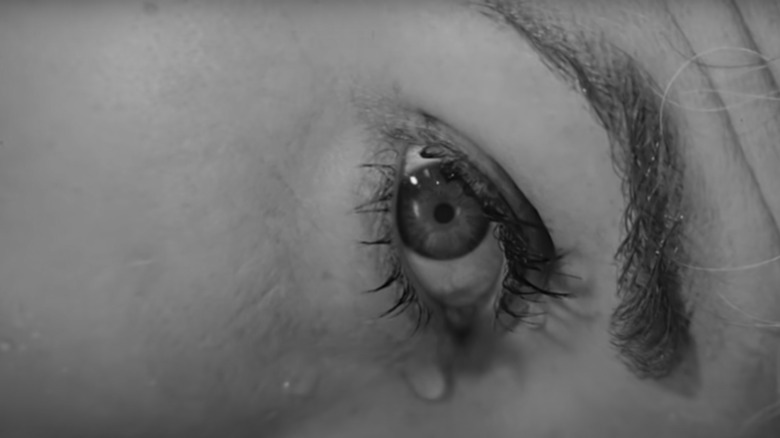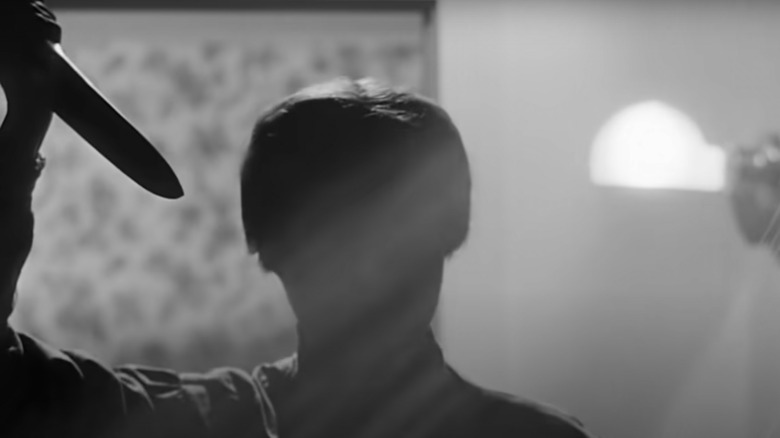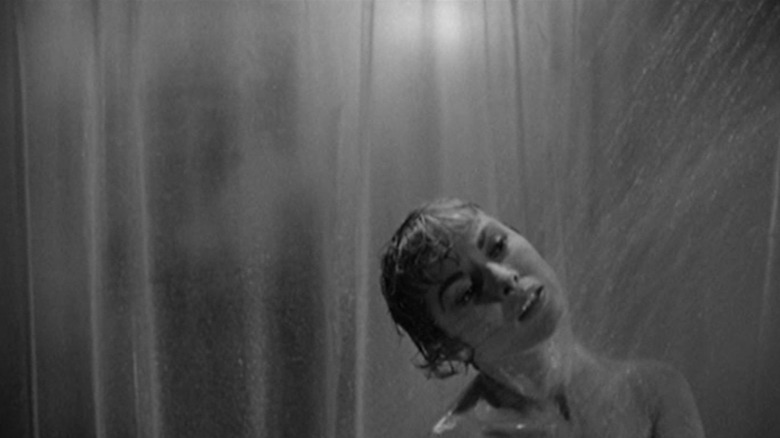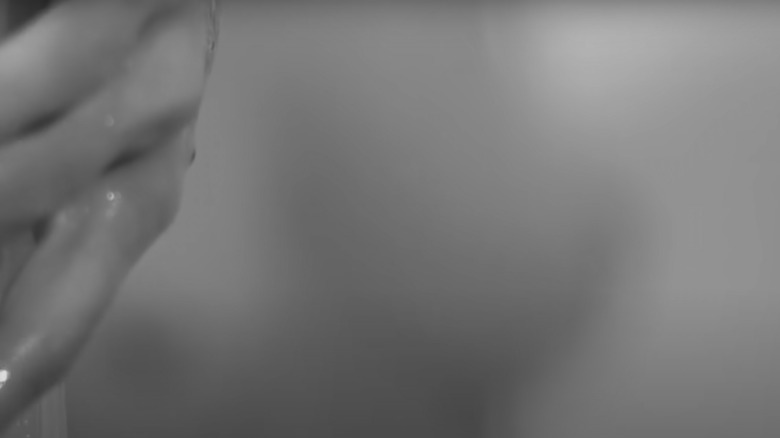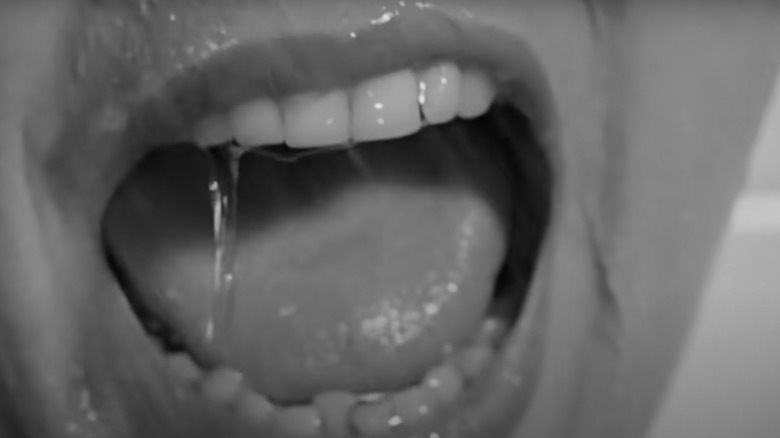Alfred Hitchcock's Psycho Dodged The Censors By Tricking Your Senses
Movie magic is a phrase that gets tossed around a lot. These days, it's become synonymous with latex prosthetics and green screens, but long before computer graphics entered the game, master filmmakers were tricking our senses with editing magic. Early pioneers, like Georges Méliès, merely enjoyed all the new sleight of hand they could pull off by cutting and splicing film, while later greats like Hitchcock used editing to elevate horror and avoid censorship.
In the late '50s, Hollywood filmmakers were still under the thumb of censors, who followed the Hays Code, which was a set of rules that covered everything from costumes to content within a movie. Nudity, sexuality, and violence were big no-nos, which caused Hitchcock to get creative, and a bit rebellious while filming "Psycho." To meet the standards of The Motion Picture Production Code, Hitchcock pulled off some editing tricks that confused censors and frightened audiences.
Master of suspense
The majority of modern scary movies are full of graphic violence, naked bodies, and buckets of blood, which often earns a jump or yelp when paired with the film's boogie man. While this is a respectable recipe for fright, Hitchcock proved that a horror sequence doesn't need nudity, gore, or a bunch of naughty bits to scare the crap out of the audience.
Despite being one of the most famous death scenes in cinematic history, the killing of Marion Crane (Janet Leigh) in "Psycho" has none of the expected gore of a typical horror scene, but still manages to elicit tension and chills from viewers. Hitchcock couldn't rely on entrails and nudity for scares because of The Hays Code restrictions, so he used rapid cutting between a plunging knife and a screaming Crane to suggest graphic violence and chocolate syrup in the place of fake blood. These tricks might sound amateurish, but, with careful planning, in the hands of "The Master of Suspense," they were groundbreaking.
Despite the ever-watchful eye of censors, Hitchcock crafted a scene that equals the creepiness and intensity of any modern slasher sequence by combining clever editing with a screeching violin, a knife-wielding killer, and just a smidge of nudity.
Close-ups, moleskin patches, and casaba melons
In an interview with Roger Ebert, Hitchcock described himself as having "a strongly visual mind," which meant that he often saw the final cut he wanted for the film while he was writing the script. Because of this, he was often bored by the rest of the filmmaking process, and disappointed by the inadequacy of the real finished film. However, aside from writing, Hitchcock also gained some joy from solving, what he called, "delightful technical problems," and "Psycho" had plenty of them.
Planning the gruesome murder of Marion Crane in the time of censorship took a lot of planning, and Hitchcock devoted himself to the process. Prior to shooting, he employed Saul Bass, who previously designed the title sequences for "Vertigo" and "North by Northwest," to create storyboards for "Psycho." Bass' drawings include familiar images of Bate's looming shadow, Janet Leigh's reaching hand, the extreme close-up of her eye, and a number of other recognizable images that Hitchcock brought to the screen.
While storyboards are a useful tool for planning camera shots, Hitchcock had plenty of other kinks to work out before cameras rolled, like mimicking the sound of stabbing flesh, and appeasing censors by preventing nip slips. According to History, after some trial and error, Hitchcock decided that a casaba melon had the proper sound he wanted for the stabbing, and moleskin patches would cover Leigh's private regions.
Despite Hitchcock's thorough planning, it took an entire week to film the shower sequence, but the result is one of the most well-known and suspenseful scenes in film. And all it took was some careful preparation, a creepy villain, and a vulnerable victim. Oh yeah, and the censor's approval.
Tricking the censors
When censors viewed "Psycho," they were appalled by the sight of a woman in a bra and slip, lying on a hotel bed with a shirtless man. The mere suggestion of sex lit their hair on fire, so their entire bodies must have burst into flames when they saw a nude Marion Crane get brutally stabbed by a psycho killer and collapse against a tile floor.
The horrified censors insisted they'd seen naked breasts, pierced flesh, and fresh blood, but all that was merely figments of their imaginations brought about by Hitchcock's genius techniques. Well, most of it was, anyway.
Hitchcock was supposed to reshoot the scene to comply with censorship, but instead, he sent the censors the same footage they had found so offensive. When they watched the scene a second time, they were confused about what they'd actually seen the first time around. The censors approved the scene, perhaps too ashamed to admit that the initial gore and sexuality were products of Hitchcock's suggestive film techniques and their own dirty minds.
Hitchcock avoided graphic violence with the clever use of close-ups, quick cuts, and chocolate syrup, but he actually managed to slip in just a bit of nudity by confusing the censors. Turns out, they'd been right the first time. The final version of the censor-approved film shows out-of-focus breasts as a dying Crane grabs the shower curtain. Scandalous!
A new scare
Lulled into a false sense of security by rampant censorship, 1960s audiences reacted to Hitchcock's film with sheer horror. The Village Voice reported that "People bolted for the doors and fainted in their seats" during the film's creepier sequences, and that one theater in New York even had to call the police to deal with the audience. It's the kind of response that would make headlines years later when audiences first saw "The Exorcist," but "Psycho" caused it without all the green pea soup and demonic possession. Hitchcock baffled censors and terrified audiences with good, old-fashion preparation and the magic of film.
